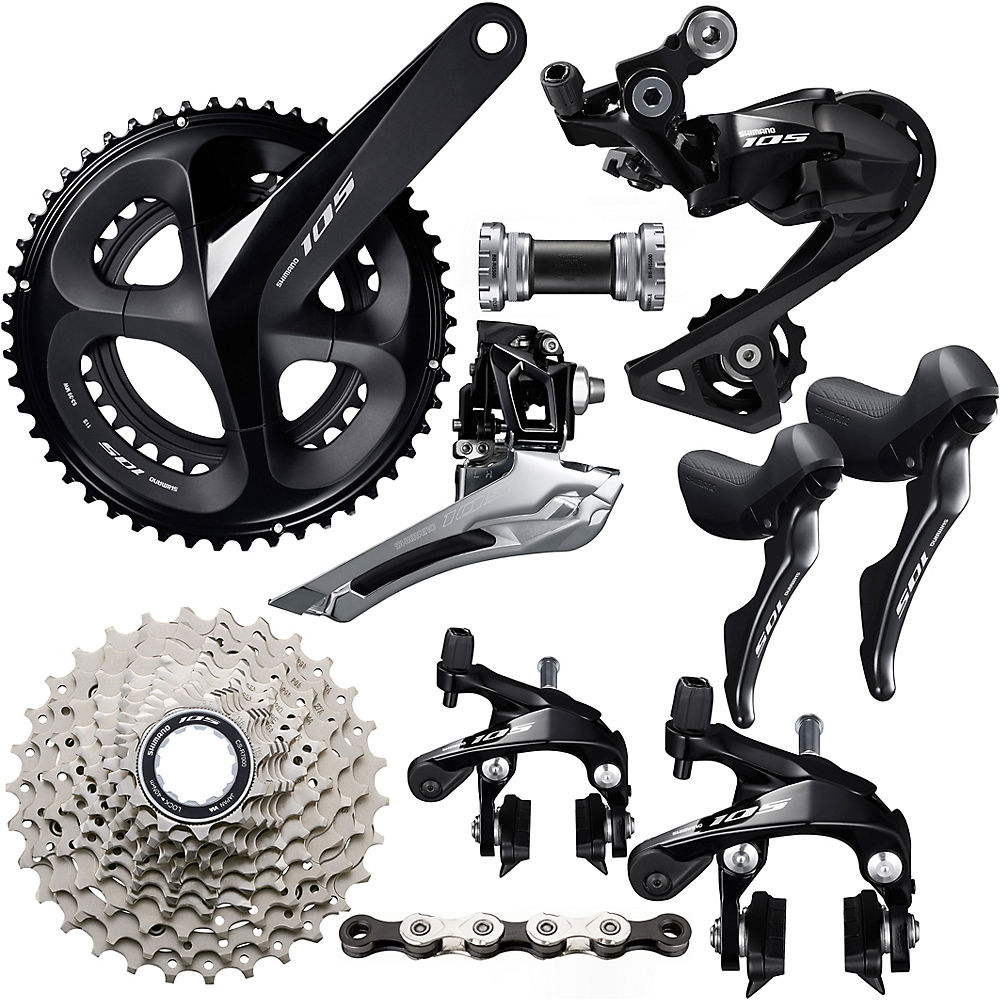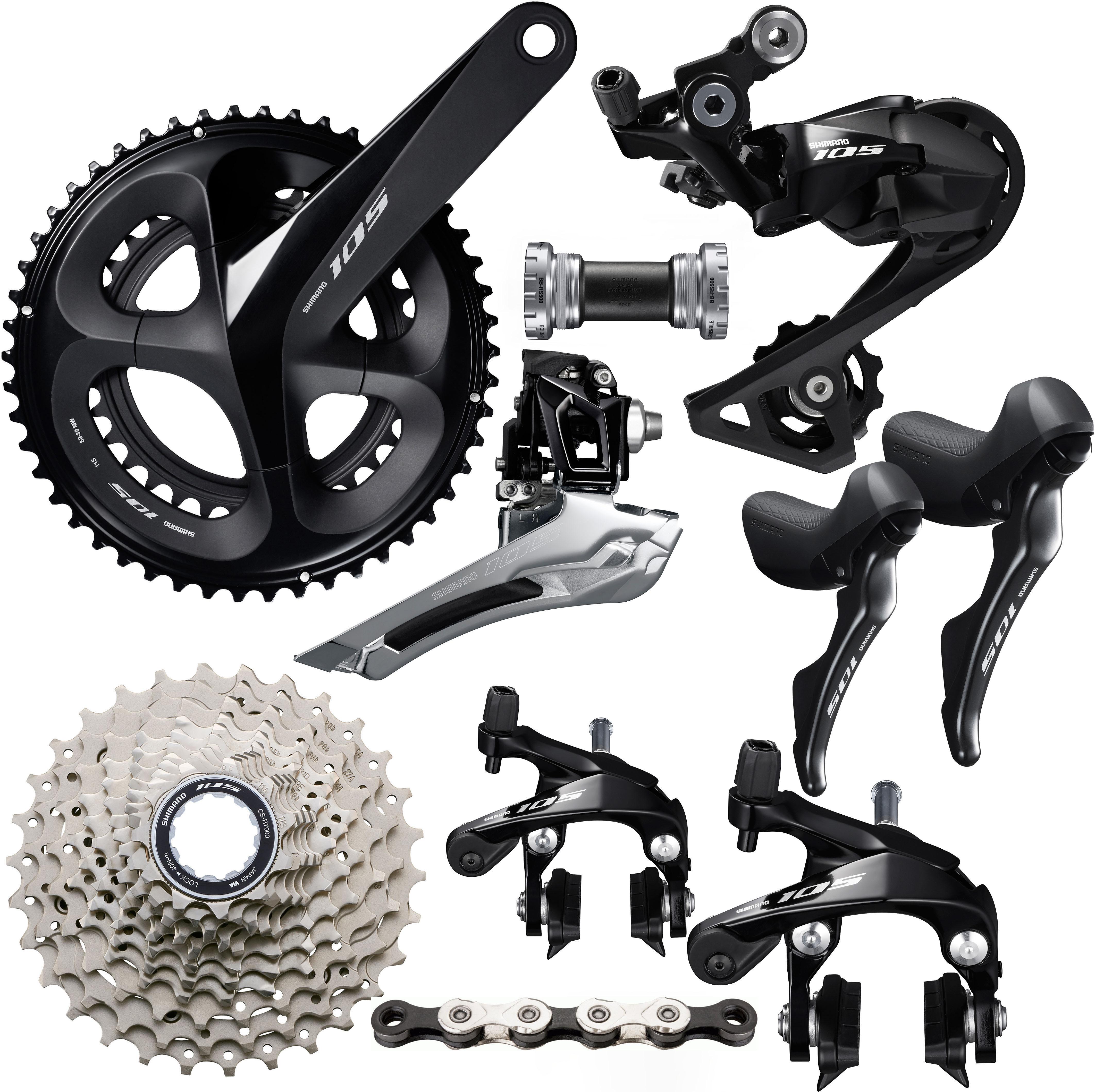Shimano 105 R7000 has become one of road cycling’s biggest clichés, but for good reason. The mid-level groupset represents not only very good value for money, but also benefits from the trickle-down of technologies from the Japanese super-brand’s higher level groupsets, Ultegra and Dura-Ace.
Available in strictly mechanical, 11-speed guise (at the time of writing), Shimano 105 is the go-to for anybody seeking reliability, durability and ease of adjustment and maintenance.
It’s also worth noting that, despite the RRP quoted above, you’ll hardly ever need to pay that sum, given the clamour for sales among online retailers.
Whether you opt for disc brakes (105 R7020) or more traditional rim brakes (105 R7000), the overall picture is much the same: you’d be a fool not to fit 105.
Shimano 105 groupset: Levers and shifting

The shifting arrangement of the Shimano 105 ST-R7020 levers operates in the tried and tested Shimano fashion.
Both levers accommodate a smaller paddle shifter, which on the left hand side returns the chain to the small chainring, and on the right hand side selects a harder gear.
The brake levers themselves pivot with a push inwards, and perform the opposite function to the paddles. The construction differs from the firm’s higher end groupsets in that plastic and alloy are used, albeit with glass fibre reinforcement, rather than the carbon-reinforced material of Ultegra and Dura-Ace.
Where this system differs from the mid-level groupsets from rivals such as Campagnolo and SRAM is that it is happily devoid of any mechanical ‘clunk’; each shift is slotted home with an accuracy and fluidity of movement that allows almost seamless progress on the road.

The hoods are slightly bulbous and taller than most, a shape necessitated by the placement of the remote mineral oil reservoir for the hydraulic brake fluid, and this extra height does take a little getting used to for the first few rides if you’re used to mechanical disc or rim brake hoods.
The textured finish affords decent enough grip, while a pronouned curve to the lever itself makes braking operation more comfortable when riding on the drops.
While this is rather finger length-dependent, the levers are adjustable for reach, by way of a 2.5mm hex key inserted in the outward facing plastics (once you’ve peeled back the cover of the hood).
For the incredibly tiny of hand – or indeed children – there is a smaller R7025 version of the levers. If your chosen gear causes the chain to impact with the front derailleur (which is available as a brazed-on or clamp model), a half-shift movement of both levers will trim the gears.
The front derailleur has an in-built tension adjuster which allows tiny tweaks to mech position, while cross-chaining won’t cause such a ‘fingernails down the blackboard’ sensation now that a small block of rubber is positioned on the inner of the derailleur.
Additionally, an R7000 lever and hood setup is available for rim brake bikes.
Shimano 105 groupset: Rear derailleur

The Shimano 105 RD-R7000 11-speed rear derailleur is available in either a short cage (SS) or medium cage (GS) format.
The former covers cassettes with up to a 30-tooth maximum size gear, while the latter accommodates casettes with a 34-tooth sprocket, and both are available in either black or silver.
A 2mm hex key is all you’ll need to adjust the clearance of the pulley wheel, with clockwise turns moving it further away from the cassette.
The last bike I rode, the new Basso Venta Disc 105, ran a Shimano 11-32 cassette with a medium cage rear derailleur, and did suffer initially with gears that were reluctant to shift promptly.
A little tweak of the thumb and forefinger-operated barrel adjuster where the gear cable enters the rear mech eliminated this with relative ease.
Shimano 105 groupset: Crankset and bottom bracket

The R7000 chainkset is another example of Shimano Hollowtech aluminium alloy componentry. The crank arms are forged around a steel block which is later removed, to create a hollow crank arm.
But don’t think for a second that this equates to anything which feels less than rock solid; you’d need specialist equipment to register the slightest amount of flex on a set of Shimano Hollowtech crank arms.
Although I favour a 170mm or 172.5mm (depending on the frame geometry), besides these two sizes, the cranks are available in 160mm, 165mm and 175mm lengths.
Crucially, while packing grease and other slimy cleaning fluids are a pain to get off the gloss-finished crankset, the surface is particularly durable, suffering from no discernible heel rub across countless bikes I’ve owned and ridden that have been fitted with Hollowtech kit.
The chainring arrangement is offered in either 50/34 ‘compact’, 52/36 ‘mid-compact’ or 53/39 ‘the industry standard 10 years ago’ versions, and given that the 110 bolt circle diameter is shared across the entire Shimano range, there’s an obvious avenue to mixing and matching elements of the firm’s higher level groupsets to your 105 crankarms.
The 24mm steel axle allows the use of outboard bearings for 68mm bottom bracket shells, although my experience in recent years with Shimano 105 applies to the 86.5mm press-fit SM-BB72-41 bottom bracket, an example of the trickle-down effect from the Ultegra groupset.
The whole shebang is intended by Shimano to combine optimum stiffness, weight and strength. Yes, the setup is heavier than its more performance-minded stablemates, but the difference is next to unnoticeable, especially for the difference in money you’ll spend in search of a handful of grams’ weight loss.
Shimano 105 groupset: Cassette, freehub and chain

The 11 cogs of the Shimano 105 cassette are fabricated from steel, and carried on aluminium alloy arm. Four different sizes of 11-speed R7000 cassette are available for 11-speed Shimano freehubs, while an HG700 cassette – also 11-speed but in just one 11-34 option (11-13-15-17-19-21-23-25-27-30-34) – is compatible with 10-speed freehubs, given that it contains a removable spacer. Ideal for retro-upgrading on to older wheelsets.
Additionally, the 11-speed R7070 freehub is 10-speed compatible when a spacer is fitted.
The R7000 gearing options are 11-28, 11-30, 11-32, 11-34 and a good old-fashioned close-ratio 12-25 setup. While the last of those, in my experience, offers the slickest gearchanges owing to the smaller size differences between cogs, the most common cassette, often allied to a 50/34 chainset, is the 11-32 option, as it offers the greatest range of gears for most terrain, and equipped the Basso Venta Disc 105 I most recently tested with all-day ability.
Shimano 105 R7000 cassette ratios
| 11-28 | 11-12-13-14-15-17-19-21-23-25-28 |
| 11-30 | 11-12-13-14-15-17-19-21-24-27-30 |
| 11-32 | 11-12-13-14-16-18-20-22-25-28-32 |
| 11-34 | 11-13-15-17-19-21-23-25-27-30-34 |
| 12-25 | 12-13-14-15-16-17-18-19-21-23-25 |
The HG601-11 chain features 114 links, treated to a PTFE coating on its inner links which is claimed to increase durability and make gearchanges smoother.
Under load, and under speed, I’ve found the Shimano 105 chain meshes with the cassette in a slightly less slick manner to Ultegra or Dura-Ace, but nothing worse than that. Be aware that it comes without a quick-link, instead relying upon a connecting pin for fitment.
Shimano 105 groupset: Brakes

For those of us still running rim brakes (and why not, after all?), the Shimano 105 R7000 options are either dual-pivot or direct mount up front, with both being compatible with tyres up to 28c.
Besides the two options at the rear, there is also an under bottom bracket-mounted R7010-R caliper designed for aero bikes and offering, in my experience, much less power due to its location on the frame. Think of it more as a ‘speed arrester’ than a brake.
When it comes to the Shimano 105 groupset R7020 disc brakes, hand on heart I couldn’t hope for better performance for the money. Easy-bleed flat-mount calipers are the only options available, and are most often paired with 160mm discs on complete road and gravel builds.
Their fitment, using the Shimano Centre Lock system is simplicity itself (slot on to spline, tighten lockring, secure wheel to frame using tool-free 12mm thru-axle). Braking performance is abrupt when required, easily moderated when preferred, and comfortably performed thanks to the ergonomically pleasing hoods and easily adjusted reach to the levers from the drops.
Yes, the stainless steel outers squeal a bit when the discs and pads are bedding in, but pad clearance is generous, the rotors are compatible with metal or resin pad materials, and are essentially a maintenance-free setup you can rely upon in all weathers.
Shimano 105 groupset weights
Claimed weights for individual components are as follows:
| Levers | 610g per pair |
| Front derailleur | 95g (braze-on), 111g (band-on) |
| Rear derailleur | Shimano 105 R7000 |
| Cassette | CS-R7000: 284g (11-28), 304g (11-30), 320g (11-32), 269g (12-25); CS-HG700: 379g (11-34) |
| Chain | 257g |
| Crankset | 713.4g (50-34), 742.6g (52-36), 757.8g (53-39) |
| Bottom bracket | 69g (press-fit), 77g (threaded) |
| Brake calipers | 147g (front flat-mount caliper), 138g (rear); Dual-pivot: 379g per pair; Direct-mount 348g per pair; Under bottom bracket rear caliper: 173g |
| Brake rotors | 193g (203mm), 159g (180mm), 133g (160mm), 121g (140mm) |
Shimano 105 groupset: price
Individual component pricing for 105 is as follows (R7000 prices are in brackets if different to R7020):
- Lever (each): £279.99 (£229.99)
- Front derailleur: £41.99
- Rear derailleur: £54.99
- Cassette: £54.99
- Chain: £34.99
- Crankset: £159.99
- Bottom bracket: £28 / $33 / €33
- R7020 calipers (each): £59.99
- Brake rotors: £29.99 (£44.99 for rim brake calipers)
Shimano 105 groupset verdict: Do you really need Ultegra?

The launch of the 12-speed, semi-wireless electronic Ultegra R8100 and Dura-Ace R9200 groupsets in 2021 have detached those two tiers somewhat from the rest of Shimano’s road range.
That said, 11-speed, mechanical Ultegra R8020 is still theoretically available, so it is relevant to weigh up against the similarly-specced 105 R7020. Simply put, there are only two good reasons that you might consider Ultegra R8000: weight and price.
I’d argue that the extra monetary layout doesn’t justify the performance benefit, unless you’re utterly obsessive about cutting more weight from your mechanical groupset.
If you want to save weight anywhere, the options for adapting the crankset with higher spec parts are many. And if you want to experience a truly demonstrable change in the way your bike performs, my first route would be to change the wheels beneath it.
The durability and ease of operation (and in the main, fitment) of a Shimano 105 groupset justifies its vaunted position as the perfect compromise between weight and performance.
Photos: Joseph Branston






